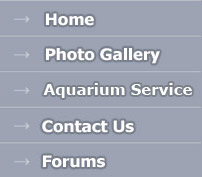


Product Search |
Products |
||||||||||||||||||||||||||||||||||||||||||
|
Water ChangesThere's just no getting around it; sooner or later, every aquarium needs a water change. No filter system can extract 100% of the waste materials that accumulate in our tanks. These waste materials can make the water cloudy or yellow, stunt our fishes' growth, and can lead to stress and sickness. Therefore, the question is not if we should change water, but rather how we should go about it. Many inexperienced aquarists (and some who should really know better) use the "kill 'em with kindness" approach. They allow the aquarium water to go unchanged for months until it is almost unbearable for the fish. Then they strip the aquarium and virtually sterilize everything, often putting their poor fish in various buckets and bowls about the house while the cleaning is being performed. The result is often disastrous. If the fish somehow survive the ordeal of being netted twice, put in water which is dramatically different from that to which they've become accustomed, and just being terrified in general, they find that the worst is yet to come. Their nice, clean home is actually too clean, as the aquarist has eliminated all of the "good guy" bacteria that normally break down fish waste. As the bacteria re-establish themselves during the following weeks, fish waste accumulates, ammonia or nitrite levels shoot up, and the fish weaken, and perhaps die. A much better approach is to change smaller portions of water more often, and to leave the fish right in the tank while you're doing it. A good average would be to change one third of the aquarium water every two weeks, or better still, every week. Once per month is the bare minimum, and usually leads to declining water quality. More frequent water changes wouldn't hurt (some fancy guppy breeders change water every day!), but are rarely necessary. Keep in mind that seldom is it advisable to change more than one third at a time. Also remember that topping off an aquarium for evaporation doesn't count. When water evaporates, only clean, pure H2O goes out; all the dissolved waste stays behind in the aquarium. The following is a simple guideline for making a water change:
|